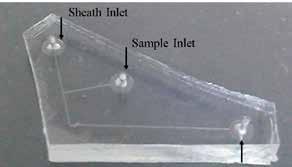
Hydrodynamic focusing is a simple yet effective technique for flow focusing and control. It can be utilised in applications such as on-chip microfluidic flow cytometry, flow switches, generation of microdroplets, and micromixers. Hydrodynamic focusing can be 2D or 3D.In 2D focusing, the sample fluid is compressed/ sandwiched only in one direction by the two side flowing sheath fluids. However, 3D focusing allows for sample being completely surrounded with sheath fluid in all directions, and this is realised by compressing the sample flow in both the horizontal and vertical directions. The aim of the current work is to develop a 3D hydrodynamic focusing microdevice for making cells move in a single file; thereby allowing their properties to be probed unambiguously at a sensing station. Not many prior designs have successfully demonstrated 3D hydrodynamic focusing. The few available earlier designs are difficult to fabricate and/or require substantially more number of accessories for their functioning. In this context, we have developed a novel approach for 3D focusing utilising two bends
of opposite curvature in a microchannel. The design is demonstrated through both experiments and numerical simulations. The proposed microdevice is fabricated on a single layer of
polydimethylsiloxane (PDMS) and a single sheath inlet is used, thereby simplifying the 3D focusing mechanism and reducing the requirements of cost enhancing accessories. The microdevice provides several distinct advantages over other designs in the literature. The design has been comprehensively proved with dye, particles, and blood cells.The developed microdevice is being commercialised through a start-up, Embryyo Bio-Microdevices Pvt. Ltd. We have received funding under the prestigious Longitude Prize Discovery Award 2017 from Nesta UK to use thistechnology towards tackling the rising incidences of anti-microbial resistance.
Prof. Amit Agrawal
